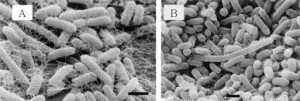It has been 30 years since the initial emergence and subsequent rapid global spread of multidrug-resistant Salmonella enterica serovar Typhimurium DT104 (MDR DT104).
 Nonetheless, its origin and transmission route have never been revealed. We used whole-genome sequencing (WGS) and temporally structured sequence analysis within a Bayesian framework to reconstruct temporal and spatial phylogenetic trees and estimate the rates of mutation and divergence times of 315 S. Typhimurium DT104 isolates sampled from 1969 to 2012 from 21 countries on six continents.
Nonetheless, its origin and transmission route have never been revealed. We used whole-genome sequencing (WGS) and temporally structured sequence analysis within a Bayesian framework to reconstruct temporal and spatial phylogenetic trees and estimate the rates of mutation and divergence times of 315 S. Typhimurium DT104 isolates sampled from 1969 to 2012 from 21 countries on six continents.
DT104 was estimated to have emerged initially as antimicrobial susceptible in ∼1948 (95% credible interval [CI], 1934 to 1962) and later became MDR DT104 in ∼1972 (95% CI, 1972 to 1988) through horizontal transfer of the 13-kb Salmonella genomic island 1 (SGI1) MDR region into susceptible strains already containing SGI1. This was followed by multiple transmission events, initially from central Europe and later between several European countries. An independent transmission to the United States and another to Japan occurred, and from there MDR DT104 was probably transmitted to Taiwan and Canada.
An independent acquisition of resistance genes took place in Thailand in ∼1975 (95% CI, 1975 to 1990). In Denmark, WGS analysis provided evidence for transmission of the organism between herds of animals. Interestingly, the demographic history of Danish MDR DT104 provided evidence for the success of the program to eradicate Salmonella from pig herds in Denmark from 1996 to 2000.
The results from this study refute several hypotheses on the evolution of DT104 and suggest that WGS may be useful in monitoring emerging clones and devising strategies for prevention of Salmonella infections.
Global genomic epidemiology of Salmonella enterica Serovar Typhimurium DT104
Appl. Environ. Microbiol. April 2016 vol. 82 no. 8 2516-2526

.jpg) As a result of an ongoing investigation into an outbreak of Salmonella Typhimurium DT104 associated with ground beef products, the Colorado Department of Public Health and Environment (CDPHE) notified FSIS of the problem. Epidemiological investigations and a case control study conducted by CDPHE and the Centers for Disease Control and Prevention (CDC) determined that there is an association between the fresh ground beef products and 14 illnesses reported in Colorado. The illnesses were linked through the epidemiological investigation by their less common pulsed-field gel electrophoresis (PFGE) pattern found in PulseNet, a national network of public health and food regulatory agency laboratories coordinated by the CDC.
As a result of an ongoing investigation into an outbreak of Salmonella Typhimurium DT104 associated with ground beef products, the Colorado Department of Public Health and Environment (CDPHE) notified FSIS of the problem. Epidemiological investigations and a case control study conducted by CDPHE and the Centers for Disease Control and Prevention (CDC) determined that there is an association between the fresh ground beef products and 14 illnesses reported in Colorado. The illnesses were linked through the epidemiological investigation by their less common pulsed-field gel electrophoresis (PFGE) pattern found in PulseNet, a national network of public health and food regulatory agency laboratories coordinated by the CDC.